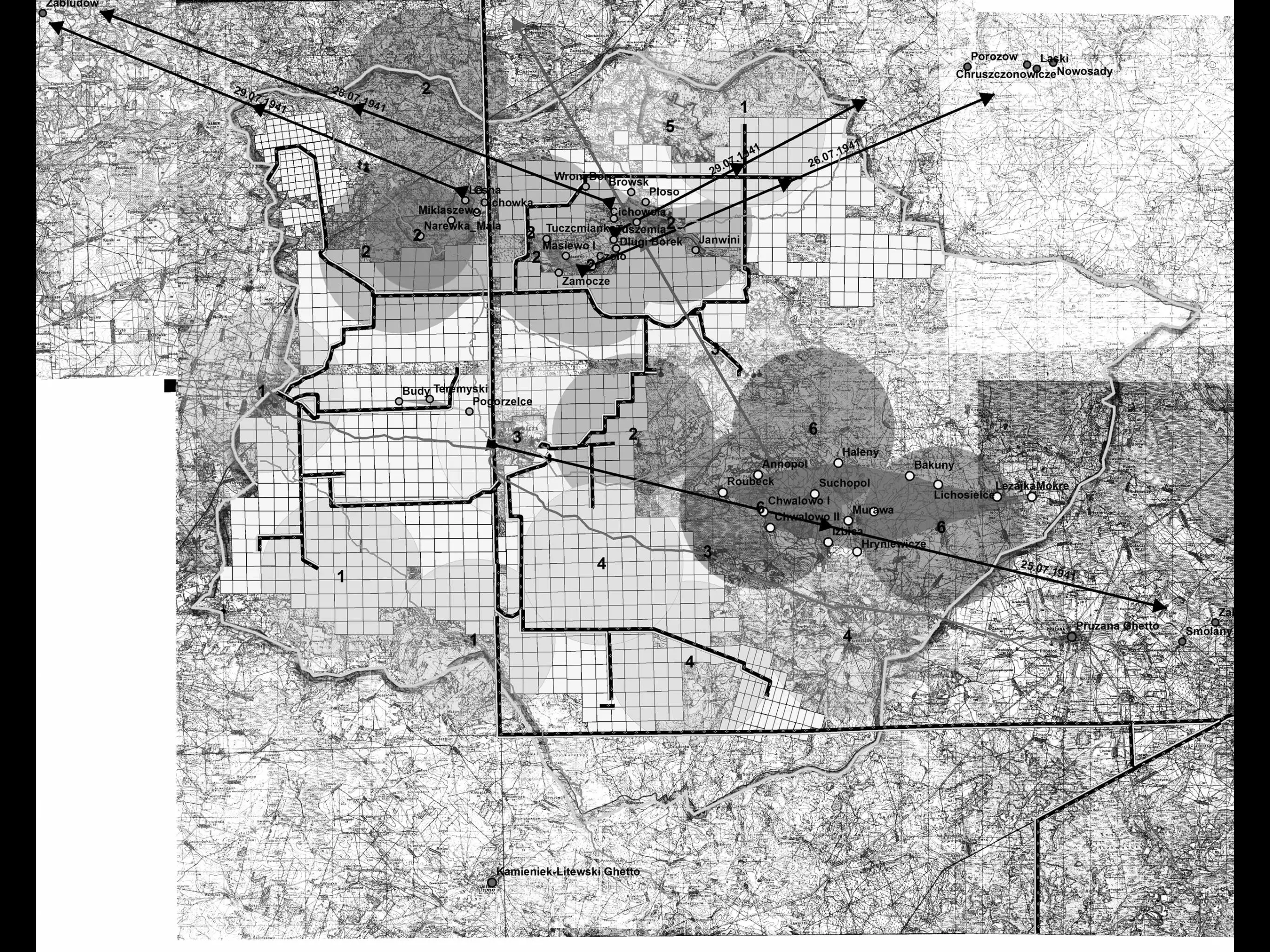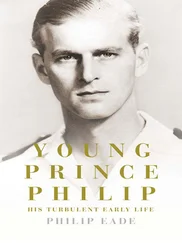This book contains more than twenty maps, the majority are from the Historical GIS analyses. The map below (uncaptioned) is an example of our first results. This is a composite map and although highly detailed it’s also a picture of information overload caused by the density of layering and grayscale. The ‘buffers’, or roundels, represent patrol distances within company areas and also radio signals ranges for small wireless devices. Arrow lines give general directions of patrols and deportations. The Germans incorporated the Jagen system, which represented a square kilometre ground—reflected in the grid pattern. This was an old Tsarist form of measurment used in Białowieźa for forestry management. The squares were mapped into the German maps and renamed Jagen. All of these factors have remained constant. However, in an effort to reduce the sense of clutter, we experimented with single layer maps and then with specific theme maps.

The solution we finally decided to accept were specific to the general findings from the research and forensic in design. The maps were finalised after series of experiments with colour, black and white, multiple layering, and single layer analysis. The GIS maps are in a specific set of representations: the orders of battle or deployment of companies (maps: 3, 4, 12, 13, 14, 20); the Bandenbekämpfung actions (6, 10, 16, 17); population engineering (5); Judenjagd (7,8,9, 11, 18); and larger operations (19, 21).
Alongside the GIS maps, the number of photographs were selected to contrast contemporary images of war with postwar memory. The aim was to visualize the concept of 'victims, bystanders and perpetrators' so prominent in Holocaust literature.
The conjunction of memory and mapping represents how communities co-exist within a landscape scarred by war and the Holocaust. Memories cast in the stone memorials stand in all Eastern European and Russian communities; this is an aspect of the Holocaust that is unique to the landscape. Maps and memories are germane to any microhistory of the region. 26
1A.J.P. Taylor, The Course of German History: A Survey of the Development of German History Since 1815, (London, 1961), p. 2.
2Dan G. Cox and Thomas Bruscino (ed), Population-Centric Counterinsurgency: A False Idol? SAMS Monograph Series, CSIP, US Army CAC, (Kansas, 2011).
3AŠarūnas Liekis, 1939: The Year That Changed Everything in Lithuania’s History, (Amsterdam, 2010), pp. 82–83; see also Norman Davies, Europe: A History, (London, 1996), p. 904.
4Walter Frevert, ‘Zehn Jahre Jagdherr in Rominten’, Wild und Hund, (1943), pp. 148–153.
5Robert T. Foley, Alfred von Schlieffen’s Military Writings, (London, 2003).
6Discussions with archivists of the Bundesarchiv Militärarchiv. At the time of writing, there is uncertainty over the numbers of maps produced by the Wehrmacht.
7Edward P.F Rose, Dierk Willig, ‘German Military Geologists and Geographers in World War II’, in Studies in Military Geography and Geology, 2004, pp. 199–214.
8TNA, WO 208/3619, Interrogation Reports, CSDIC (UK), SIR 1706–1718, interrogation number 1709, German Army Warrant Officer Dr. Bartz 19 July 1945. He was described as a university geography lecturer, who returned to Germany after working in the USA and was conscripted into the army.
9Sören Flachowsky und Holger Stoecker (Hg), Vom Amazona an die Ostfront. Der Expeditionsreisende und Geograph Otto Schulz-Kampfhenkel (1910–1989), (Köln, 2011).
10Hermann Häusler, ‘Forschungsstaffel z.b.V. Eine Sondereinheit zur militärgeografischen Beurteilung des Geländes im 2. Weltkrieg.’ Schriftenreihe, MILGEO Institut für Militärisches Geowesen, Heft 21/2007.
11Eric Hobsbawm, On History, (London, 1997), p. 201.
12Anne Kelly Knowles, Tim Cole, Alberto Giordano (ed), Geographies of the Holocaust, (Bloomington, 2014). See also the essential secondary source was Ian N. Gregory and Paul S. Ell, Historical GIS: Technologies, Methodologies and Scholarship, (Cambridge, 2007); also, Anne Kelly Knowles (ed), Past Time, Past Place: GIS for History, (California, 2002).
13Bettina Wunderling BSc. Geology (Göttingen), a certification in GIS (Kiel), and has studied at Aachen-RWTH. The GIS modelling was carried out with ARC GIS version 10.0 by ESRI Software.
14Hein Klemann & Sergei Kudryashov, Occupied Economies: An Economic History of Nazi-Occupied Europe, 1939–1945, (London, 2012), plate 1.
15This digital map represented the longest period of research and analysis prior to the full application of historical GIS.
16Anne Kelly Knowles (ed), Past Time, Past Place: GIS for History, (Redland, 2002).
17David Rumsey and Meredith Williams, ‘Historical Maps in GIS’, in Knowles (ed), ibid., pp. 1–18.
18David W. Lowe, ‘Telling Civil War Battlefield Stories with GIS’, in Knowles (ed), ibid., pp. 51–63.
19Ian N. Gregory and Paul S.Ell, Historical GIS: Technologies Methodologies and Scholarship, (Cambridge, 2007).
20Geographisches Institut, Christian-Albrechts-Universität zu Kiel, May 2009–March 2010.
21Jonathan Raper, Multidimensional Geographic Information Science, (London, 2000).
22Institute of Historical Research, Historical Mapping and GIS, (research training), May 2013.
23Association of the US Army, Annual Conference, October 2006.
24US Army Colonel Roger Cirillo, PhD retired supplied a copy: ‘Report of the Department of the Army Review of the Preliminary Investigations into the My Lai Incident’, Volume 1: Report of the Investigation, 14 March 1970.
25Alberto Giodano and Anna Holian, ‘Retracing the “Hunt for Jews”: A Spatio-Temporal Analysis of Arrests during the Holocaust in Italy’, and Waitman Wade Beorn and Knowles, ‘Killing on the Ground and in the Mind’ in Knowles et al, Geographies of the Holocaust, (Bloomington, 2014).
26For an example of this, see the travelogue in Omer Bartov, Erased .
Knuff was a crafty and cuddly stag as his name implied, but he was elderly, and his days numbered. Although this mighty stag had large antlers he was reduced to the status of a commoner. There were too many weak points in his vital statistics that denied him a place in the regal stock book. Regardless of Knuff’s less than noble pedigree, Hermann Göring had honoured the beast by selecting him for his hunting record. In his last hours, Knuff led Göring on a merry dance across der Romintener Heide. Göring stalked the stag for a week but the ‘old gentleman’ simply refused to surrender. For only the briefest moments Knuff tantalisingly presented his flanks but never long enough to be shot. After five hours of fruitless stalking in the morning, Göring was resigned to failure and trundled off to breakfast. Just about to tuck into a hearty platter, the mighty hunter received a telephone call from a forester that Knuff had been sighted. Leaving his continental breakfast behind, he dashed off eager for the kill. Göring mounted a shooting stand, took aim, and with a masterful shot he killed Knuff. This was the supreme moment—the sublime one-shot kill, a ‘… staggering phenomena that successful fighter pilots are good shots’, wrote Göring’s biographer. 1While anecdote has shaped the myths about Göring, the tale of Knuff represents a narrative about the hunt and the Luftwaffe lost from history.
Hermann Göring is a complicated character, with a façade that is not always reflected in the literature. In the past, his biographers have been compelled to condemn rather than delve beyond the superficial. In this literature, Göring is painted as the Nazi archetype of failure. This notion is also reflected in the balance of books on the man: mostly about Göring and the Luftwaffe; a few books about Göring and the Nazi economy; and a handful of books about Göring and forestry. Consequently, we know more than we need to know about his failings with the Luftwaffe but know less than is necessary to fully comprehend his part in the Holocaust. These depictions do not give us a rounded view of Göring. For example, in 1945 when examined by allied psychiatrists, he was regarded as the most intelligent and unscrupulous of the Nazi war criminals held in the Nuremberg cells. In the courtroom, he rallied from apathy to become the last champion of Nazism and the guardian of his legacy. To start at the end, therefore, would inevitably lead to the conclusion that he was a deviant, unscrupulous, clever, dogged by physical issues, had an addiction to morphine, but ultimately cheated the hangman with suicide. 2
Читать дальше













